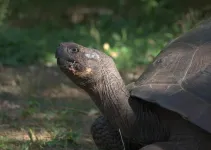(Press-News.org) A first-of-its-kind, international study of 107,000 children finds that higher temperatures are an equal or even greater contributor to child malnutrition and low quality diets than the traditional culprits of poverty, inadequate sanitation, and poor education.
The 19-nation study is the largest investigation of the relationship between our changing climate and children's diet diversity to date. It is believed to be the first study across multiple nations and continents of how both higher temperatures and rainfall--two key results of climate change--have impacted children's diet diversity.
"Certainly, future climate changes have been predicted to affect malnutrition, but it surprised us that higher temperatures are already showing an impact," said lead author Meredith Niles, an assistant professor of Nutrition and Food Sciences at the University of Vermont and a fellow at the university's Gund Institute for Environment.
Led by University of Vermont researchers, the study examines diet diversity among 107,000 children 5 and under in 19 countries in Asia, Africa, and South America, using 30 years of geo-coded temperature and precipitation data, and socioeconomic, ecological, and geographic data.
The study finds that the negative effects of climate--especially higher temperature--on diet diversity are greater in some regions than the positive effects of education, water and sanitation and poverty alleviation--all common global development tactics. The findings were published today in Environmental Research Letters.
Of the six regions examined--Asia; Central and South America; North, West, and Southeast Africa, five had significant reductions in diet diversity associated with higher temperatures.
Researchers focused on diet diversity, a metric developed by the United Nations to measure diet quality and micronutrient intake. Micronutrients, such as iron, folic acid, zinc, and vitamins A and D, are critical for child development. A lack of micronutrients is a cause of malnutrition, which affects one out of every three children under the age of five. Diet diversity is measured by counting the number of food groups eaten over a given time period.
On average, children in the study had eaten food from 3.2 food groups (out of 10)-- including meat and fish, legumes, dark leafy greens and cereal greens--in the previous 24 hours. By contrast, diet diversity in emerging economies or more affluent countries such as China have been more than double this average (6.8 for children 6 and under).
"Diet diversity was already low for this group," said UVM co-author Brendan Fisher. "These results suggest that, if we don't adapt, climate change could further erode a diet that already isn't meeting adequate child micronutrient levels."
Severe childhood malnutrition is a significant global challenge. According to the United Nations, 144 million children under age 5 were affected by stunting in 2019, an effect of chronic malnutrition. In 2019, 47 million children under 5 suffered from wasting, or acute undernutrition the UN says, a condition caused by limited nutrient intake and infection.
The study also found that higher precipitation, another potential effect of climate change in some regions, was associated with higher child diet diversity. In some cases, the effect of higher precipitation had a greater impact on child diet diversity than education, improved sanitation or greater forest cover.
"Higher rainfall in the future may provide important diet quality benefits in multiple ways, but it also depends on how that rain comes," said co-author Molly Brown of the University of Maryland. "If it's more erratic and intense, as is predicted with climate change, this may not hold true."
The study builds on UVM global research into how nature improves both children's health, their diets, and human well-being. The findings suggest that, in addition to addressing current needs, policy makers need to plan for improving diets across the most vulnerable in the future with a warming climate in mind.
"A warming climate has the potential undermine all the good that international development programs provide," said co-author Taylor Ricketts, Director of UVM's Gund Institute for Environment. "In fact, that is something we find again and again in this global research: continued environmental degradation has the potential to undermine the impressive global health gains of the last 50 years."
INFORMATION:
The research team included Meredith Niles, Taylor Ricketts, Brendan Fisher and Serge Wiltshire (University of Vermont), Molly Brown (University of Maryland), and Benjamin Emery (Sandia National Laboratories).
DALLAS, Jan. 14, 2021 -- The longer the time between when heart attack symptoms start and a patient has an artery-clearing percutaneous coronary intervention (PCI), the more damage to the heart muscle, according to new research published today in Circulation: Cardiovascular Interventions, an American Heart Association journal.
A heart attack happens about every 40 seconds in the U.S., and the most common heart attack is caused by a complete blockage in a coronary artery, called ST-elevation myocardial infarction (STEMI). STEMI patients are most often treated with PCI, also known as angioplasty with stent, in which a catheter with a deflated balloon is inserted into the narrowed heart artery. Subsequently, the balloon is inflated, which clears the obstruction and restores ...
DALLAS, Jan. 14, 2021 -- Adults who smoke or who are genetically predisposed to smoking behaviors are more likely to experience a serious type of stroke called subarachnoid hemorrhage (SAH), according to new research published today in Stroke, a journal of the American Stroke Association, a division of the American Heart Association. The results of this study provide important evidence that there is a causal link between smoking and the risk of SAH.
SAH is a type of stroke that occurs when a blood vessel on the surface of the brain ruptures and bleeds into the space between the brain and the skull. It mainly affects middle-aged adults and has high rates of complications ...
MEDFORD/SOMERVILLE (January 14, 2021) - A team of researchers led by engineers at Tufts University's School of Engineering and Stanford University's Program on Water, Health and Development have developed a novel and inexpensive chlorine dispensing device that can improve the safety of drinking water in regions of the world that lack financial resources and adequate infrastructure. With no moving parts, no need for electricity, and little need for maintenance, the device releases measured quantities of chlorine into the water just before it exits the tap. It provides a quick and ...
There is a growing consensus among scientists as well as national and local governments representing hundreds of millions of people, that humanity faces a climate crisis that demands a crisis response. New research from the University of California San Diego explores one possible mode of response: a massively funded program to deploy direct air capture (DAC) systems that remove CO2 directly from the ambient air and sequester it safely underground.
The findings reveal such a program could reverse the rise in global temperature well before 2100, but only with immediate and sustained investments from governments and firms to scale up the new technology.
Despite the enormous undertaking explored in the study, the research ...
Honeybee historians might seem like a flight of fancy but these tiny pollinators have been helping researchers from the National Botanic Garden of Wales track how the UK's fields, hedgerows, wild spaces and gardens have changed since the 1950s.Using cutting-edge DNA barcoding techniques, scientists at the Botanic Garden identified which plants modern-day honeybees visited most often by looking at the pollen grains trapped within honey.
They compared this to a 1952 survey of honey plants where a microscope had been used to painstakingly identify pollen grains in honey sent from hives across the country. The differences were clear. White clover had been the most important plant for honeybees but, with fewer pastures today and increased use of herbicides and inorganic ...
New research has unlocked the mystery of how the Galápagos Islands, a rocky, volcanic outcrop, with only modest rainfall and vegetation, is able to sustain its unique wildlife habitats.
The Galápagos archipelago, rising from the eastern equatorial Pacific Ocean some 900 kilometres off the South American mainland, is an iconic and globally significant biological hotspot. The islands are renowned for their unique wealth of endemic species, which inspired Charles Darwin's theory of evolution and today underpins one of the largest UNESCO World Heritage Sites and Marine Reserves on Earth.
Scientists have known ...
Water isn't just crucial for life, it's fundamental to increasing opportunities for women and girls in rural areas across the globe. A new Stanford study reveals how bringing piped water closer to remote households in Zambia dramatically improves the lives of women and girls, while also improving economic opportunities, food security and well-being for entire households. The research, recently published in Social Science & Medicine, could spur governments and NGOs to more carefully evaluate the costs and benefits of piped water as an alternative to less accessible communal water sources.
"Switching from the village borehole to piped supply saved almost 200 hours of fetching time per year for a typical household," said study senior ...
A new paper in Q Open finds that the availability of fast food restaurants on the route between children's houses and their schools does not affect children's weight.
Reducing the rate of childhood obesity is a top public health priority in the United States where obesity rates are 18.4% for those ages 6-11 and 20.6% for those ages 12-19. Childhood obesity is a documented risk-factor for negative physical and mental health outcomes. Obese children are also more likely to become obese adults and suffer associated health problems.
Researchers have proposed that the accessibility ...
Researchers in South Korea have developed a phototherapy technology that can significantly increase efficiency while reducing the pain of chemotherapy and minimizing side effects after treatment. The President of Korea Institute of Science and Technology (KIST), Seok-Jin Yoon announced that a research team led by Dr. Se-hoon Kim at the Theragnosis Research Center (KU-KIST Graduate School of Converging Science and Technology) has developed a cancer-targeted phototherapeutic agent that promises complete elimination of cancer cells without side effects. It involves only one injection and repeated phototherapy. This development ...
While there is an abundant amount of research about traumatic brain injuries in athletes and those serving in the military, the same data is scarce when it comes to concussions and head and neck injuries sustained due to intimate partner violence.
Carrie Esopenko, assistant professor in the Department of Rehabilitation and Movement Sciences in the Rutgers School of Health Professions says that the World Health Organization estimates that one in three women will experience intimate partner violence (IPV) in her lifetime, and studies suggest that anywhere between 30% to 90% of women who experience physical abuse at the hands of an intimate partner experience head trauma. Yet not enough data is being collected to understand how this head trauma affects cognitive and psychological ...






